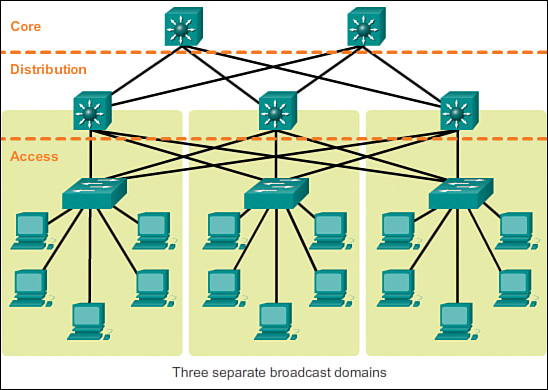Hierarchical Network Design
In networking, a hierarchical design involves dividing the network into discrete layers. Each layer, or tier, in the hierarchy provides specific functions that define its role within the overall network. This helps the network designer and architect to optimize and select the right network hardware, software, and features to perform specific roles for that network layer. Hierarchical models apply to both LAN and WAN design.
The typical hierarchical design model is broken up in to three layers:
Core layer
Core Layer consists of biggest, fastest, and most expensive routers with the highest model numbers and Core Layer is considered as the back bone of networks. Core Layer routers are used to merge geographically separated networks. The Core Layer routers move information on the network as fast as possible. The switches operating at core layer switches packets as fast as possible. Switch features in the Core layer:
- Layer 3 support
- Very high forwarding rates
- Gigabit Ethernet/ 10 Gigabit Ethernet
- Redundant components
- Link Aggregation
- Quality of Service (QoS)
Distribution layer
The Distribution Layer is located between the access and core layers. The purpose of this layer is to provide boundary definition by implementing access lists and other filters. Therefore the Distribution Layer defines policy for the network. Distribution Layer include high-end layer 3 switches. Distribution Layer ensures that packets are properly routed between subnets and VLANs in your enterprise. Switch features in the Distribution layer:
- Layer 3 support
- High forwarding rate
- Gigabit Ethernet/ 10 Gigabit Ethernet
- Redundant components
- Security policies/Access Control Lists
- Link Aggregation
- Quality of Service (QoS)
Access layer
Access layer includes access switches which are connected to the end devices (Computers, Printers, Servers etc). Access layer switches ensures that packets are delivered to the end devices. Switch features in the access layer:
- Port security
- VLANs
- Fast Ethernet/Gigabit Ethernet
- Power over Ethernet (PoE)
- Link aggregation
- Quality of Service (QoS)
The benefit of dividing a flat network into smaller, more manageable blocks is that local traffic remains local. Only traffic that is destined for other networks is moved to a higher layer.
Layer 2 devices in a flat network provide little opportunity to control broadcasts or to filter undesirable traffic. As more devices and applications are added to a flat network, response times degrade until the network becomes unusable.
Benefits of hierarchical network design
The main benefits of Cisco Three-Layer hierarchical model is that it helps to design, deploy and maintain a Scalable, trustworthy, cost effective hierarchical inter-network.
Better Performance: Cisco Three Layer Network Model allows in creating high performance networks
Better management & troubleshooting: Cisco Three Layer Network Model allows better network management and isolate causes of network trouble.
Better Filter/Policy creation and application: Cisco Three Layer Network Model allows better filter/policy creation application.
Better Scalability: Cisco Three Layer Network Model allows us to efficiently accommodate future growth.
Better Redundancy: Cisco Three Layer Network Model provides better redundancy. Multiple links across multiple devices provides better redundancy. If one switch is down, we have another alternate path to reach the destination.





how to implement osi policy
why need core layer